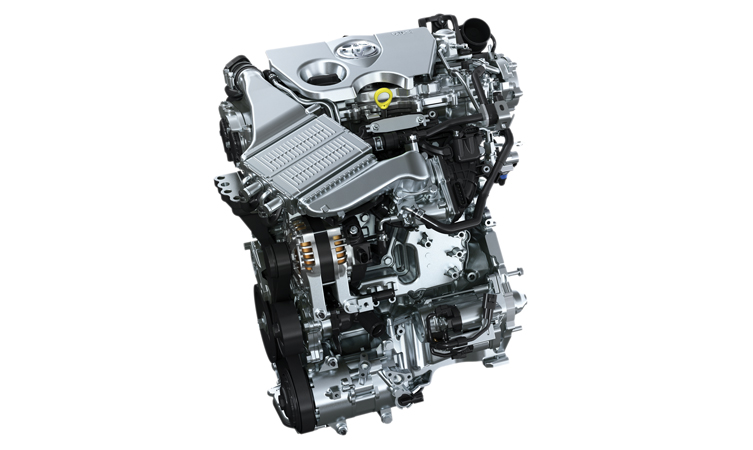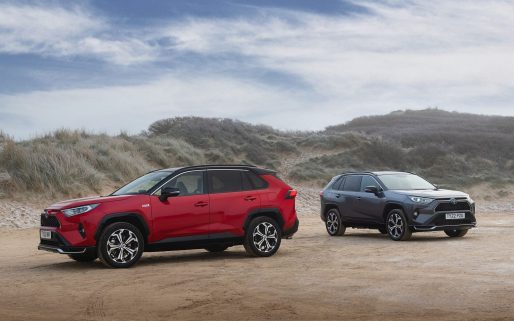The Toyota 1.2T, an all-new, direct injection turbocharged petrol engine, makes its global debut in the new Toyota Auris.
It belongs to the range of 14 new engines that Toyota is launching globally between April 2014 and the end of 2015.
Last year Toyota announced its plan to introduce a series of new, highly fuel-efficient engines, created using a number of combustion and loss-reduction technologies that had previously been reserved for hybrid engines.
See also:
LIVE – Toyota at the 2015 Geneva Motor Show
New Toyota Auris 2015 revealed
Toyota Auris 2015: design explained
Toyota Auris 2015: engine line up explained
The new four-cylinder 1.2T engine is the second unit from this family to come to Europe bearing the Toyota badge, following on from the three-cylinder 1.0-litre engine that was introduced in new Aygo and Yaris in 2014.
Like the 1.0-litre, the 1.2T uses advanced technologies that allow it to change from the Otto to the Atkinson cycle when running under low loads, vertical vortex high tumble air flow intake ports, an exhaust manifold integrated in the cylinder head and advanced heat management measures.
The 1.2T adds to this a direct injection system and a water-cooled turbo and heat exchanger. Furthermore, the VVT-i intelligent variable valve timing system featured on the 1.0-litre is upgraded to a VVT-iW (Variable Valve Timing – intelligent Wide) system, which allows even more valve timing flexibility.
The combination of these technologies results in outstanding performance and efficiency.
With a displacement of just 1,197cc, the engine delivers 114bhp (85kW) and constant torque of 185Nm between 1,500 and 4,000rpm. It will push the new Auris hatchback from rest to 62mph in 10.1 seconds. Acceleration from 50 to 75mph in fifth gear takes 13.7 seconds, and top speed is set at 124mph.
All of this is achieved despite a focus on fuel economy and CO2 emissions: the car achieves 60.1mpg* on the combined cycle and 109g/km* of CO2.
Securing better performance with higher efficiency
The key to achieving this level of fuel consumption without compromising performance is to apply higher compression, but generally, as compression increases, so does the risk of uncontrolled combustion – “knocking”.
The 1.2T’s high 10:1 compression ratio has been made possible thanks to a series of technologies that improve control of the combustion process. This way, the risk of knocking can be avoided.
First, the intake ports have been designed to generate a more intense flow and a “vertical vortex” and the piston shape has been optimised to improve in-cylinder turbulence. As a result, fuel and intake air mix faster and form a more homogenous mixture. This leads to a higher combustion speed, which helps prevent knocking.
Advanced heat management in itself is a great way to improve fuel economy, but it is also another way to reduce the risk of knocking. The 1.2T engine was designed in such a way that the temperature of each individual part can be optimised. For example, the bottom of the pistons is cooled by oil jets and the cooling of the cylinder head is separate from that of the engine block. This means the temperature in the combustion chamber can be reduced, while keeping the block itself hot enough to reduce friction.
Direct injection makes a contribution as well, as it helps dissipate the heat in the combustion chamber, and the charge air passes through the intercooler, which uses a low-temperature cooling circuit.

1.2T: low-end torque and quick response
A low-inertia turbocharger, the VVT-iW valve system and the D-4T direct injection system work together to ensure excellent torque delivery, from the lowest engine speeds.
Together with the limited-volume intake system, this ensures immediate response when the accelerator pedal is pressed.
The injection system has been newly developed for the 1.2T engine. Compact in design, it is perfect for use in a small displacement engine. It allows multiple injections per cycle and the optimised width and reduced length of the spray pattern ensure combustion quality, regardless of engine regime and load.
From Otto to Atkinson
The VVT-i system operates on both the intake and the exhaust side, and allows torque to be maximised at all engine speeds. In addition, the VVT-iW allows for intake valve closing to be delayed, which means the engine can operate in both the Otto and Atkinson cycle.
The Atkinson cycle is used in extremely low engine load conditions, when the intake valve remains open for a fraction of time, after the compression stroke has set in, allowing part of the gas charge to be pushed back into the intake. As a result, the effective compression stroke is shortened.
Pumping losses are reduced, as there is less pressure on the piston, and the throttle valve can be opened wider.
Quick and smooth stop and start
A new start control has been developed to ensure quick and smooth engine restart. When the system shuts down the engine, it controls the stop position to leave the piston half way in the compression stroke.
On restart, it applies stratified injection in the first compressed cylinder to counter vibrations. And by retarding the ignition, torque increase is kept in check, preventing the engine from revving excessively, thus ensuring a calm and confident take-off.
| Toyota Auris 1.2T | Technical specifications |
|---|---|
| Engine type | 4-cylinder in-line |
| Injection | Direct |
| Displacement (cc) | 1,197 |
| Bore x stroke (mm) | 71.5 x 74.5 |
| Compression ratio | 10:1 |
| Max. power (bhp/kW @rpm) | 114/85 @ 5,200 – 5,600 |
| Specific power (bhp/litre) | 95.2 |
| Max. torque (Nm @ rpm) | 184 @ 1,500 – 4,000 |
| Specific torque (Nm/litre) | 154.6 |
| CO2 emissions (g/km, EU combined cycle) 6MT | 109 |
| CO2 emissions (g/km, EU combined cycle) CVT | 106 |
| Max speed (mph) | 124 |
| 0-62mph (sec) | 10.1 |





Does the 1.2T have oil dilution problems as it has a turbo and direct injection? Also would it have carbon build up on the intake valves as it doesn’t have port injection?
Hi,
We’re not aware of any issues with this powertrain. Of course, carbon build up affects all combustion engine. Generally speaking, you can help reduce carbon build up by regularly changing engine oil, and using high quality oil as well as high quality fuel.
Thanks
Hi,
Can you please advise when the timing belt should be changed on our 2017 Auris 1.2T auto. We purchased used last November with 43,006 on the clock. Thank you.
Hi Elaine,
Thanks for your comment.
Your Toyota Centre would be best placed to advise on this.
We hope this helps.
Thanks.
Hello I would like ask you a question is auris 1.2 automatic 2016 how is the MPG in city thanks for your time
Hi,
Due to the age of this vehicle, it is important for you to understand that the official fuel economy figure was determined using the old NEDC test. The ‘urban’ figure from this test is 46.3-47.9mpg depending on specification. In reality, we expect you would achieve less than that.
This is why the new WLTP test was introduced, so that customer would see a more realistic figure. Saying that, it is impossible to full replicate real world driving in a standardised test, because there are so many variables involved with driving, not least driving style!
Thanks
Hi there , what fuel should I be running my 1.2t on ? thanks
Hi Mike,
Please provide your vehicle registration so we can look into this for you.
Thanks.
hi there , I’m not located in the UK I am from Australia , I imported my car from japan and got it last week. no one here seems to know anything about the JDM 1.2 turbo corolla so I haven’t been driving it very much until I know what fuel to run it on, don’t want to run it on too low of octane but also don’t want to pay for high octane and flush $$ away if its not needed haha ,
Hi Mike, thanks for your comment.
We are only able to advise on UK specification vehicles, apologies.
Toyota UK
I have CH-R 1.2T 2018 model Im using normal petrol , Is that okay or I need to change to super petrol
Hi,
Any unleaded petrol currently on sale in the UK can be used in your C-HR.
Thanks!
Hi, I have auris 1.2T 2015 and it overheats – goes into red -under hard acceleration and drops to normal when accelerator released. Are there any common issues for this symptom as toyota can’t fault it and it has had changed both thermostats, coolant pump and sensors.
Thanks
Hi Peter,
Thanks for your comment.
Unfortunately, this is something that we are unable to diagnose online.
For any issues you are having with your Auris, we would recommend contacting your Toyota Centre.
Thanks.
Hi Peter,
we have the same problem as you discribe in a message on 30 June 2022, about cooling problems on a Auris 1.2T.
What did you do to solve this problem?
i hope you receive this message and will anser it.
With kind regards
Kevin Mols
Toyota Dijkstein
The Netherlands
Hello I’ve got exactly the same problem have you had it resolved
Hello I have the same problem can you help me did you get the problem resolved?
Hi,
Hope this message finds you well. I have a 2015 Auris, purchased used @24,000 miles. Just curious, is it normal when I start the engine that it has a sound of high revs( above 1,000rpm as per tachometer), then goes to normal idle sound below 1,000 rpm. I have observed this character since I bought it, nonetheless being ultra low milage, it was not repaired for anything.
Looking forward to hear from you.
Hi JP, thanks for your comment.
If you are concerned about your vehicle and would like a technician to view your car, we would recommend contacting your local Toyota centre.
You can locate your nearest Toyota centre here: https://www.toyota.co.uk/find-a-dealer
Thanks.
Hi I have the 2022 Toyota levin 1.2L turbo 4cylinder. I live in Ethiopia where the weather is mostly sunny and hot with averages of 70-80 degrees F and never get below 50 degrees F. What oil viscosity is ok to use for my car.
Hello Dave,
Thank you for getting in touch.
We would recommend your owners manual for the specific oil requirements of your vehicle. This can be found by searching your VIN on the link below.
https://www.toyota.co.uk/customer/manuals
Many Thanks
Toyota UK
Is the 1.2t engine fitted in the proace a Toyota made engine or is it peugeot/citroen?
Tx
Hi there, thanks for getting in touch.
The engine in the Proace is a Stellantis product.
Thanks,
Toyota UK
Looking at the picture above, it is the engine of my Auris 1.2T without a shadow of a doubt. Forgive my ignorance, but – that huge black thing on the left, winding its way around a number of pulleys, looks suspiciously like a timing BELT, yet I am assured that this model has a timing chain, in common with the majority of current Toyota models. Numerous motoring blogs have affirmed that my car has a CHAIN.
Please clarify.
Hi Andrew, thanks for getting in touch.
Your local Toyota Centre is best placed to check this for you.
Thanks,
Toyota UK